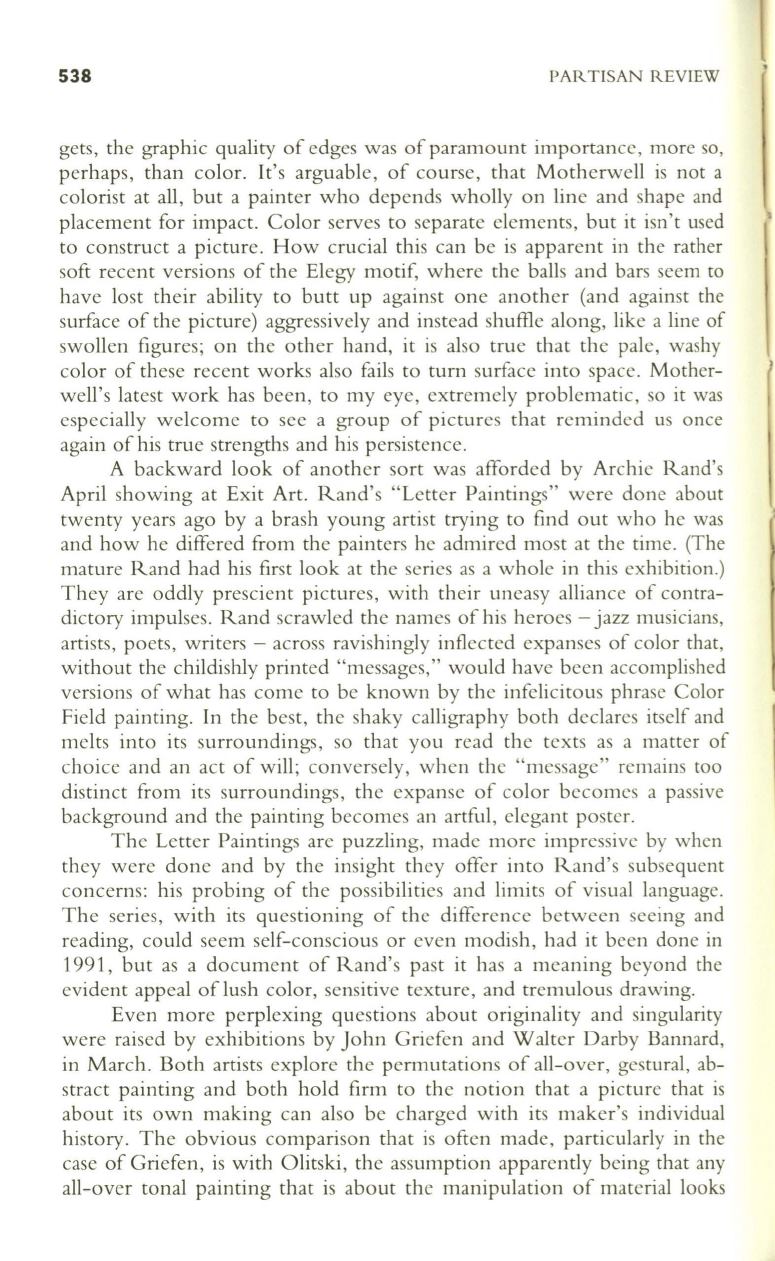
538
PARTISAN REVIEW
gets, the graphic quality of edges was of paramount importance, more so,
perhaps, than color. It's arguable, of course, that Motherwell is not a
colorist at all, but a painter who depends wholly on line and shape and
placement for impact. Color serves to separate elements, but it isn't used
to construct a picture. How crucial this can be is apparent in the rather
soft recent versions of the Elegy motif, where the balls and bars seem to
have lost their ability to butt up against one another (and against the
surface of the picture) aggressively and instead shuffie along, like a line of
swollen figures; on the other hand, it is also true that the pale, washy
color of these recent works also fails to turn surface into space. Mother–
well's latest work has been, to my eye, extremely problematic, so it was
especially welcome to see a group of pictures that reminded us once
again of his true strengths and his persistence.
A backward look of another sort was afforded by Archie Rand's
April showing at Exit Art. Rand's "Letter Paintings" were done about
twenty years ago by a brash young artist trying to find out who he was
and how he differed from the painters he admired most at the time. (The
mature Rand had his first look at the series as a whole in this exhibition.)
They are oddly prescient pictures, with their uneasy alliance of contra–
dictory impulses. Rand scrawled the names of his heroes - jazz musicians,
artists, poets, writers - across ravishingly inflected expanses of color that,
without the childishly printed "messages," would have been accomplished
versions of what has come to be known by the infelicitous phrase Color
Field painting. In the best, the shaky calligraphy both declares itself and
melts into its surroundings, so that you read the texts as a matter of
choice and an act of will; conversely, when the "message" remains too
distinct from its surroundings, the expanse of color becomes a passive
background and the painting becomes an artful, elegant poster.
The Letter Paintings are puzzling, made more impressive by when
they were done and by the insight they offer into Rand's subsequent
concerns: his probing of the possibilities and limits of visual language.
The series, with its questioning of the difference between seeing and
reading, could seem self-conscious or even modish, had it been done in
1991, but as a document of Rand's past it has a meaning beyond the
evident appeal of lush color, sensitive texture, and tremulous drawing.
Even more perplexing questions about originality and singularity
were raised by exhibitions by John Griefen and Walter Darby Bannard,
in March. Both artists explore the permutations of all-over, gestural, ab–
stract painting and both hold firm to the notion that a picture that is
about its own making can also be charged with its maker's individual
history. The obvious comparison that is often made, particularly in the
case of Griefen, is with Olitski, the assumption apparently being that any
all-over tonal painting that is about the manipulation of material looks


